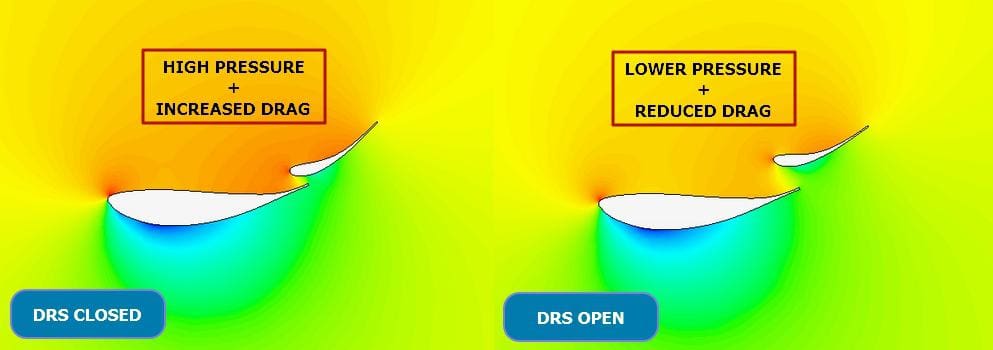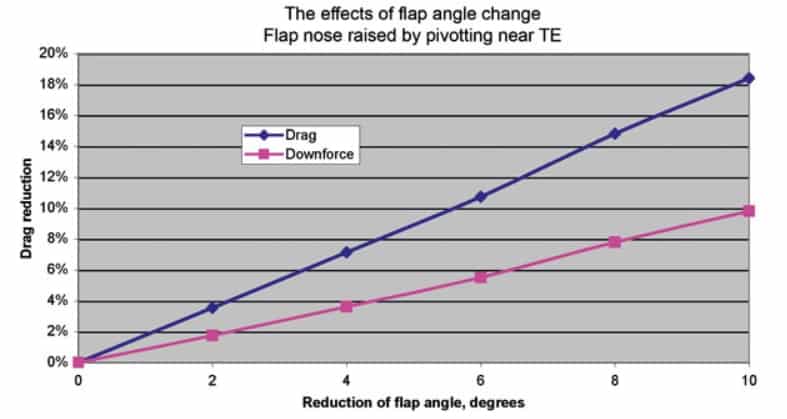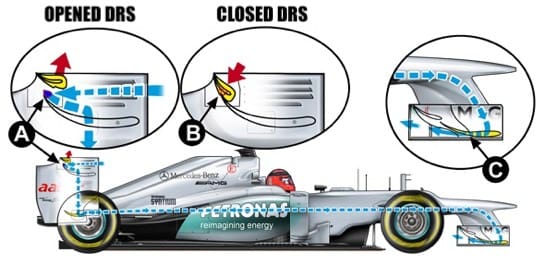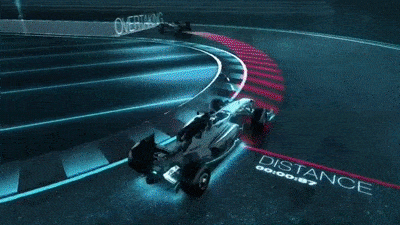How F1 DRS works?
F1 DRS and F-duct aerodynamics explained
How DRS works in F1.
An interesting innovation from the aerodynamic point of view has been the recent introduction of the “DRS” (Drag Reduction System), that is a device that allows the reduction of the downforce acting on the vehicle with less adherence to the asphalt and therefore an increase in speed, but also with a decrease in stability.
DRS system and the overtaking problem in Formula One.
The use of the “DRS”, in fact, is allowed to facilitate overtaking and therefore the show, only on long straights and only for the car that follows, provided that the distance from the previous one is less than a second. When closed, it guarantees greater adherence, useful in medium-slow curves. Let’s going on with how DRS works in F1! If you want to know more about F1 rear wing aerodynamics do not miss our article with CFD explanation (CFD explained F1 rear wing)
The first DRS system, the F-duct: a McLaren-Mercedes invention.
When the DRS is activated the upper flap is raised (A) leaving uncovered an oval hole placed on the lateral bulkhead in which air that arrives on the wing is channeled. When the DRS is not operating (B), the lowered flap completely covers the hole and the air does not enter. The air channeled into the open hole passes inside the side bulkheads, goes downwards and enters the lower flap, going into a duct that crosses the whole machine and goes into the nose. From there it passes inside the side bulkheads that support the front wing, goes downwards and goes inside the main flap which has one or more slits in the lower area, the air comes out of these slits (C) sending stalled the front wing and giving more top speed.
READ: THE F1 PORPOISING EXPLAINED
Exploiting F1 DRS to stall the front wing reducing drag.
Today aerodynamics is the sector that can guarantee the greatest gain in terms of performance: an evolution of a wing tested for a few days in the wind tunnel at the expense of a few thousand dollars can allow an improvement even half a second per lap , when to obtain the same advantage in terms of performance with an evolution of the engine it could take months and millions of dollars, with long tests on the bench and on the track, and with the danger of compromising reliability. The almost obsessive study of the details, therefore, both as regards aerodynamics and as regards materials, has become fundamental.
Let’s explain how DRS works in Formula One: what it is and working principle.
Today’s Formula 1 cannot do almost anything without DRS. An abbreviation that translates into Drag Reduction System, or friction reduction system. We are talking about a mechanism that opens the rear wing, thus reducing air resistance. In this way the cars go faster. An increase in performance of about 5-7 km / h is estimated. The actuation takes place via a button on the steering wheel of the cars, and is automatically deactivated when braking or always using the same button. Introduced since 2011, this novelty has brought challenges into a new dimension.
FIA technical regulation about F1 DRS. What does the regulation say?
DRS can only be used when permitted by regulation. Everything is managed by an FIA control unit, positioned on each car, which enables its use by turning on a warning light on the driver’s steering wheel. The use of this device is clarified in the great regulation of the Federation, in norm 21.5. In detail, the DRS can be activated:
- In the race after two laps from the start or restart of the safety car.
- Only if a driver has a gap of less than one second compared to the one who precedes him when he passes in front of the “DRS detection point”.
- It can be used in the race and in qualifying, only in the predetermined and drawn areas of the circuit.
- The FIA may have the option to disable the DRS for security reasons at any time. When? For problems related to visibility, weather conditions and accidents.
The predecessor of DRS: the McLaren F-Duct system.
The ancestor of the DRS is called f-duct. It is an invention by McLaren engineers, good at drawing a project for an intelligent system designed to “stall” the rear wing. Able above all to exploit a hole in the regulation, which at the time did not regulate this futuristic solution. As all the other stables create and install the mechanism on their cars, the FIA has thus invented the DRS and inserted all the standards. The f-duct, which is activated manually inside the car via a lever, disappears. Also because it is not safe: the driver, in addition to the concentration on the track and the thousand buttons on the steering wheel, cannot also think of a manual lever. Now, with DRS, everything is managed electronically. That today, with an even larger rear wing, has become more effective.
Focus: the FIA regulation on DRS use.
27.5 Driver adjustable bodywork permitted by Article 3.18 of the F1 Technical Regulations:
a) The adjustable bodywork may only be activated by the driver in any of the pre-determined activation zones around each circuit. In conditions of poor visibility however the race director may, at his absolute discretion, disable all such systems until conditions improve.
If the adjustable bodywork is disabled in this way at any time during any of the three periods of the qualifying practice session (Q1, Q2 or Q3) it will remain disabled for the remainder of the relevant period.
When can the DRS system be activated?
For the sole purpose of improving overtaking opportunities during the race the adjustable bodywork may be activated by the driver after he has completed two laps after the race start or following a safety car period.
The control electronics on DRS system in F1.
The driver may only activate the adjustable bodywork in the race when he has been notified via the control electronics (see Article 8.2 of the F1 Technical Regulations) that it is enabled. It will be enabled, and may only be used by the driver, if he is less than one second behind another at any of the pre-determined detection points around each circuit. The system will be disabled by the control electronics the first time the driver uses the brakes after he has activated the system.
DRS system is disabled with poor visibility conditions.
In conditions of poor visibility, or if yellow flags are being shown in the activation zone, the race director may, at his absolute discretion, disable all such systems until conditions improve or yellow flags are withdrawn.
The FIA may, after consulting all competitors, adjust the above time proximity in order to ensure the stated purpose of the adjustable bodywork is met.
What happens if the control electronics fails on F1 DRS system?
‘In the event of a failure in the system which notifies the driver that he was within one second of the car in front, and is hence authorised to use the adjustable bodywork, the team concerned may ask the race director for permission to override the system. If permission is given in this way the onus will be upon the team concerned to ensure that their driver only uses the adjustable bodywork if he is within one second of the car in front of him.
If the failure in the system is rectified the driver may no longer use this override, the race director will notify the team if and when the fault has been remedied.’
The aerodynamics of DRS system explained.
The rear wing assembly of F1 car is constituted by a main wing profile and a flap profile. For a comprehensive explanation of a F1 rear wing part assembly and aero features check our related article (The aerodynamics of F1 rear wing). An intensive research is carried out by F1 teams around the rear wing profiles. The main design parameters are the camber, the thickness and the profile sweep of the wing profile. According to the aero-setting and to the aero balance to be reached a bunch of different main wing – flap combinations are possible.
The effect of flap wing on DRS aerodynamics.
In a simplified way, the addition of the flap has the aim to increase the overall camber of the main wing, leading to an increased downforce and preventing flow separation.
The influence of DRS on the airflow.
When the airflow approaches the rear wing with DRS in closed position a large high pression area is generated on the upper side of the wing-flap profile, while a suction area is present underneath the profile. A qualitative effect of DRS effect on F1 aerodynamics is reported on the following image. The red colors identify a high pressure region while the blue one a low pressure area.

What happens when the DRS system is activated.
When the DRS system is activated, the high pressure on the upper profiles greatly declines. The reduced pressure means a reduced downforce and drag. An example of downforce and drag reduction that take place when the DRS is active are reported on the picture. By enabling the DRS system, a F1 car can have over 10 km/h gain. However, the overall impact of DRS on car performance are greatly influenced by the profile chosen as main wing. For instance, when low angle of attacks and low downforce profiles are used (i.e. in Monza), also the effectiveness of the DRS system is reduced.
DRS enabled: the main wing stalls.
One of the main aerodynamics mechanism that triggers the drag reduction is the main wing stall. In fact, when the DRS is opened and therefore the main flap has a lower angle of attack, the airflow around the main wing profile is no more able to stay attached, so the wing stall takes place. In fact, the drag reduction (or coefficient of drag reduction, see the definition in our article here) is reached by means of the following two mechanisms:
- Main plane wing stall: this causes a strong decrease in downforce and a slight increase in drag coefficient locally.
- Considerably less downforce and drag on the flap profile: reduced downforce is also related to less induced drag.

Effect of flap rotation in downforce and drag coefficient (image https://www.racecar-engineering.com)
The introduction of active aerodynamics on hypercars: Ferrari and McLaren.
Since the introduction of the DRS system in Formula One, also the top-notch road cars started implementig the introduction of active aerodynamics. In fact, most of recent hypercars have now introduced a moving spoiler as a ‘standard‘ feature. In general, the rear spoiler can be moved in order to fit the most suitable condition: high speed, balanced and handling setup. The movement of the rear spoiler is usually done by means of electric motors or hydraulic activation and coupled with an accurate electronic controls can give a unique driving experience.
Which road cars use an active rear spoiler and active aerodynamics?
Some cars that implemented the ‘DRS’ feature under the skin of moving spoiler are Lamborghini Huracán Performante (which has a system called ‘ALA‘ or Aerodinamica Lamborghini Attiva), Ferrari 488 Pista (which has a flap that lowers to bypass the diffuser when at speed) and McLaren P1 (its adjustable rear wing sits flush with the bodywork until it’s required to add some downforce. It can extend by 120mm on the road and by 300mm when in Race mode).
Another vehicle to show a DRS system very similar to that used in Formula One is the completely electric vehicle of Volkswagen ID. R, whose difference in downforce between flat condition and fully deployed rear wing is 20%.






